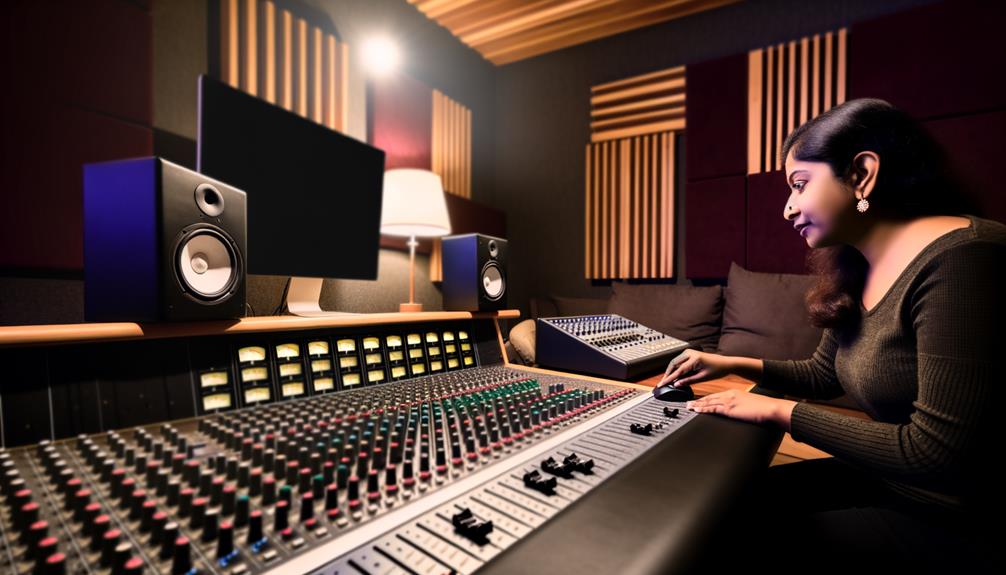No products in the cart.
Mastering music with EQ involves precise frequency balance adjustments to elevate your audio’s professionalism and clarity. Start by selecting appropriate reference tracks that exemplify ideal tonal balance and clarity. Utilizing high pass filters effectively cleans out low-frequency clutter, enhancing overall audio focus. Apply subtle EQ adjustments; small, focused changes within a 1-3 dB range can greatly improve sound balance without altering the character. Employ gentle compression to maintain dynamics while ensuring a uniform sound. Finally, always test your mastered tracks on various playback systems to guarantee consistent quality across different listening environments. Proceeding further will expand your mastery over these techniques.
Contents
hide
Key Takeaways
- Use reference tracks to assess and guide the EQ balance of your mix.
- Apply high pass filters to eliminate low-frequency clutter and enhance clarity.
- Make subtle EQ adjustments targeting specific issues with narrow Q settings.
- Utilize compression to maintain dynamics and clarity across the frequency spectrum.
- Test the mastered track on various playback systems to ensure consistent quality.
Understanding EQ Basics
EQ, or equalization, is the process of adjusting the balance of frequency components in a sound to enhance its clarity or reshape its tone. By mastering the art of frequency manipulation, you’re fundamentally sculpting the audio to fit your creative or technical needs. This involves boosting or cutting specific frequency ranges. For precise adjustments, parametric EQs are invaluable as they offer control over specific frequency bands, gain levels, and bandwidth.
Tone shaping is a vital aspect of EQ. It allows you to alter the character of a sound—whether that’s emphasizing the warmth of a bass line, clarifying the punch in a snare, or smoothing out harsh frequencies in vocals. By targeting bass, midrange, and treble frequencies selectively, you can create a more balanced and pleasing sound. This is important when you’re balancing instruments in a mix or aiming for a cohesive sound in music mastering.
Understanding these EQ basics isn’t just about knowing which knobs to turn or sliders to adjust. It’s about perceiving how different frequencies interact within your track and using this insight to make informed decisions that enhance the overall mix. This foundational knowledge is key to effectively using EQ in your music production process.
Selecting Reference Tracks
To master your own track effectively, start by selecting reference tracks that are professionally mastered and align closely with the sound and genre you’re targeting. This important step provides you with a standard against which you can measure the quality of your mix. When choosing reference tracks, look for those that exemplify excellent tonal balance and clarity. These tracks will serve as your guide, helping you understand the nuanced dynamics and stereo imaging that are hallmarks of high-quality audio engineering.
Reference tracks play a pivotal role in the mastering process by allowing you to conduct a detailed frequency analysis. Pay attention to how these tracks manage their low-end punch, the clarity of the mid-range, and the crispness of the high frequencies. This analysis will inform your mixing techniques, ensuring your track achieves a similar level of professional sound.
Moreover, using multiple reference tracks from different artists or production styles can broaden your perspective. This approach helps you avoid the pitfalls of a one-dimensional sound and ensures your track stands up to various examples of excellent audio production. Therefore, the careful selection of reference tracks underpins the success of your mastering process, driven by precision and analytical depth in audio engineering.
Applying High Pass Filters
Applying high pass filters effectively cleans up your mix by removing low-frequency clutter that can muddy the sound. When you’re working on tracks, especially those with dense arrangements or significant low-end content, setting the cutoff frequency properly is key. It’s not just about eliminating unwanted noise; it’s about enhancing the clarity and focus of your audio.
To start, you’ll need to determine the appropriate cutoff point for each track. This involves careful listening and analysis. For instance, vocals might benefit from a cutoff around 80-100 Hz to remove any rumble without affecting the warmth of the voice. Acoustic guitars, depending on their role in the mix, might’ve slightly higher cutoffs, perhaps around 100-120 Hz, to preserve their body while still clearing out low-end muddiness.
It’s important to use high pass filters judiciously. Over-filtering can lead to a thin, lifeless mix. Each track’s cutoff should be set based on its content and how it interacts with other elements in the mix. This precision ensures that while you’re removing unnecessary low frequencies, you’re also maintaining the integrity and balance of the overall sound. By improving clarity, high pass filters help in defining and separating instruments, making your mix crisp and professionally polished.
Making Subtle EQ Adjustments
After setting your high pass filters, you’ll want to fine-tune your mix by making subtle EQ adjustments to enhance overall clarity and balance. This step in frequency balancing requires a vital-focused approach, as you’re dealing with minor tweaks, typically within the range of 1-3 dB. These adjustments are essential for addressing tonal issues without making drastic changes to the sound’s character.
Focus on using narrow Q settings to surgically target specific frequencies. This method of signal processing allows for more refined sound shaping, ensuring that you maintain the integrity of the overall mix. For instance, if a vocal track slightly masks the brightness of an acoustic guitar, a slight cut in the 3 kHz range on the vocal can help the guitar’s clarity without noticeably altering the vocal’s quality.
Utilizing Compression Effectively
Utilizing compression effectively can greatly enhance your track’s cohesion and polish by controlling the dynamic range. When you’re mastering, set a threshold and ratio for gentle compression to make sure you don’t squash the audio dynamics. You’ll typically want to aim for about 0.5 to 2 dB of gain reduction. This subtle shaping maintains the natural dynamics of the track without making it sound overly compressed.
Focus on using slow attack times to preserve the natural transients and character of the music. A fast release time helps prevent the compression from affecting subsequent sounds or notes, keeping the compression transparent and effective.
Incorporating advanced sidechain techniques allows you to compress specific audio signals triggered by other tracks. This can be particularly useful in managing frequency conflicts between bass-heavy instruments and kick drums, ensuring clarity and preventing muddiness.
Multiband compression is another powerful tool. It splits the audio spectrum into separate bands that can be compressed independently. This precision allows you to target specific frequency ranges that may be more dynamic or problematic, providing a balanced sound across the entire spectrum without affecting the integrity of other frequencies.
Incorporating Limiting Techniques
Building on your understanding of compression, let’s now focus on how you can incorporate limiting techniques to maintain control over peak levels and enhance the overall loudness of your mix. Limiting, an advanced form of compression, is pivotal in mastering to prevent any potential clipping that could lead to distortion. It’s about setting a maximum output level—your ceiling—beyond which no signal can pass.
When setting thresholds, you’re essentially defining this ceiling. It’s important to set this just right; too high, and you risk minimal impact on preventing clipping, too low, and you might squash the dynamics of the track. The ideal threshold setting should ensure that only the loudest parts of your mix hit the limiter, preserving the dynamic range while still protecting against peaks.
Release settings in limiting are equally important. They determine how quickly your limiter stops affecting the signal after it falls below the threshold. A faster release can make the limiting less noticeable, but be wary of setting it too fast, as this can lead to a ‘pumping’ effect. Conversely, a slower release might smooth out the dynamics too much, creating a lifeless sound. Balancing these settings is key to a master that sounds both loud and dynamic.
Finalizing and Exporting
Finalizing your master involves carefully adjusting the limiter to guarantee that peak levels don’t exceed –0.5 to -1 dB, avoiding any potential clipping. It’s important to make sure that you’re not pushing for more than 3 dB of gain reduction with the limiter to maintain the integrity of your track’s dynamics. This precise control in the last position of your signal chain plays a significant role in the quality of the final output.
When you’re satisfied with the sound, it’s essential to test the mastered track on various playback systems. This step confirms the consistency and quality across different environments, ensuring your master performs well whether it’s played on headphones, car speakers, or studio monitors.
Next, focus on the exporting techniques. Choose the right file formats for distribution while considering the platforms your music will be featured on. Exporting in lossless formats like WAV or AIFF is typically recommended to preserve the highest quality. Ensure the settings reflect a sample rate and bit depth that match the project settings, usually 44.1 kHz and 16 bits for CD quality.
Detail-oriented exporting is important for delivering a polished, professional-sounding master that stands up to industry standards and listener expectations.
Frequently Asked Questions
How Do You Master a Song Step by Step?
To master a song, you’ll analyze its frequency balance and dynamics first. Adjust levels with parametric EQ, apply dynamic compression, and enhance stereo imaging. Finally, add subtle saturation and compression for polish.
How Is EQ Used in Mastering?
In mastering, you use EQ for frequency balancing and stereo enhancement, refining each track’s clarity and spatial distribution. This precise tool adjusts frequencies to eliminate muddiness and enhance overall sonic quality.
What Are the Basic Mastering Techniques?
In mastering, you’ll adjust compression settings and enhance stereo imaging to guarantee consistent sound across all playback systems. These techniques refine dynamics and spatial distribution, essential for achieving a polished, professional final track.
What Are the Steps to Mastering a Beat?
To master a beat, analyze its frequency balance, adjust EQ for clarity, apply dynamic EQ for resonance control, tweak compression settings, refine beat timing, and use mid-side EQ to enhance stereo width.
Conclusion
You’ve mastered the essentials of EQ and now understand how to leverage reference tracks for consistency. Using high pass filters, you’ve cleaned up unnecessary low frequencies, and your subtle EQ adjustments have fine-tuned your mix.
Compression and limiting techniques were applied strategically, enhancing dynamic control. Now, you’re set to finalize and export your track.
Remember, each step requires precise adjustments—trust your ears but confirm with analytical tools to make sure your music sounds great on any system.




